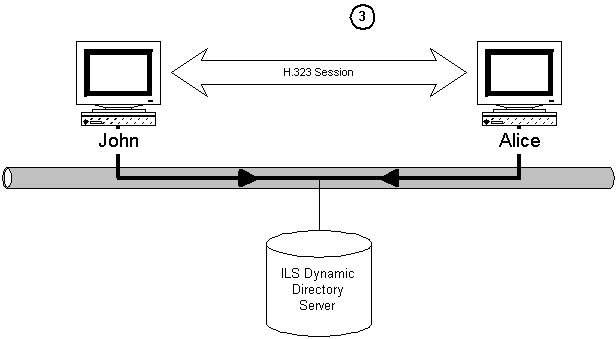
[This is preliminary documentation and subject to change.]
H.323 is a comprehensive International Telecommunications Union (ITU) standard for multimedia communications (voice, video, and data) over connectionless networks that do not provide a guaranteed quality of service, such as IP-based networks and the Internet. It provides for call control, multimedia management, and bandwidth management for point-to-point and multipoint conferences. H.323 mandates support for standard audio and video codecs and supports data sharing via the T.120 standard. Furthermore, the H.323 standard is network, platform, and application independent, allowing any H.323 compliant terminal to interoperate with any other.

H.323 allows multimedia streaming over current packet-switched networks. To counter the effects of LAN latency, H.323 uses as a transport the Real-time Transport Protocol (RTP), an IETF standard designed to handle the requirements of streaming real-time audio and video over the Internet.
The H.323 standard specifies three command and control protocols:
The H.245 control channel is responsible for control messages governing operation of the H.323 terminal, including capability exchanges, commands, and indications. Q.931 is used to setup a connection between two terminals, while RAS governs registration, admission, and bandwidth functions between endpoints and gatekeepers (RAS is not used if a gatekeeper is not present). See below for more information on gatekeepers.
H.323 defines four major components for an H.323 based communications system:
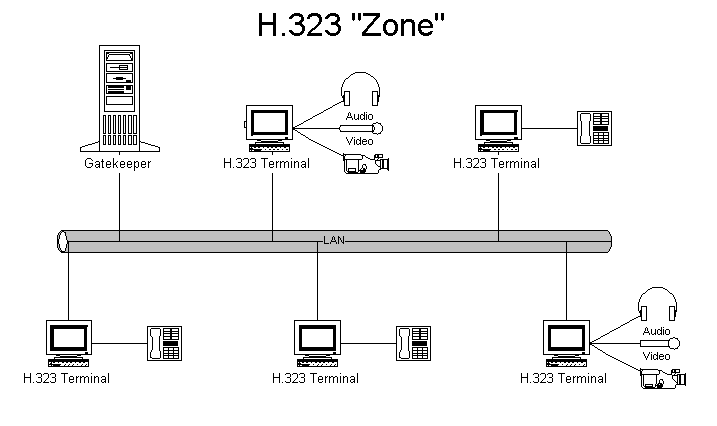
Terminals are the client endpoints on the network. All terminals must support voice communications; video and data support is optional.
A Gateway is an optional element in an H.323 conference. Gateways bridge H.323 conferences to other networks, communications protocols, and multimedia formats. Gateways are not required if connections to other networks or non-H.323 compliant terminals are not needed.
Gatekeepers perform two important functions which help maintain the robustness of the network - address translation and bandwidth management. Gatekeepers map LAN aliases to IP addresses and provide address lookups when needed. Gatekeepers also exercise call control functions to limit the number of H.323 connections, and the total bandwidth used by these connections, in an H.323 "zone". A Gatekeeper is not required in an H.323 system – however, if a Gatekeeper is present, terminals must make use of its services.
Multipoint Control Units (MCU) support conferences between three or more endpoints. An MCU consists of a required Multipoint Controller (MC) and zero or more Multipoint Processors (MPs). The MC performs H.245 negotiations between all terminals to determine common audio and video processing capabilities, while the Multipoint Processor (MP) routes audio, video, and data streams between terminal endpoints.
Any H.323 client is guaranteed to support the following standards: H.261 and G.711. H.261 is an ITU-standard video codec designed to transmit compressed video at a rate of 64 Kbps and at a resolution of 176x44 pixels (QCIF). G.711 is an ITU-standard audio codec designed to transmit A-law and µ-law PCM audio at bit rates of 48, 56, and 64 Kbps.
Optionally, an H.323 client may support additional codecs: H.263 and G.723. H.263 is an ITU-standard video codec based on and compatible with H.261. It offers improved compression over H.261 and transmits video at a resolution of 176 x 44 pixels (QCIF). G.723 is an ITU-standard audio codec designed to operate at very low bit rates.
The H.323 Telephony Service Provider (along with its associated Media Stream Provider) allows TAPI-enabled applications to engage in multimedia sessions with any H.323-compliant terminal on the local area network.
Specifically, the H.323 Telephony Service Provider (TSP) implements the H.323 signaling stack. The TSP accepts a number of different address formats, including name, machine name, and email address.
The H.323 MSP is responsible for constructing the DirectShow filter graph for an H.323 connection (including the RTP, RTP payload handler, codec, sink, and renderer filters).
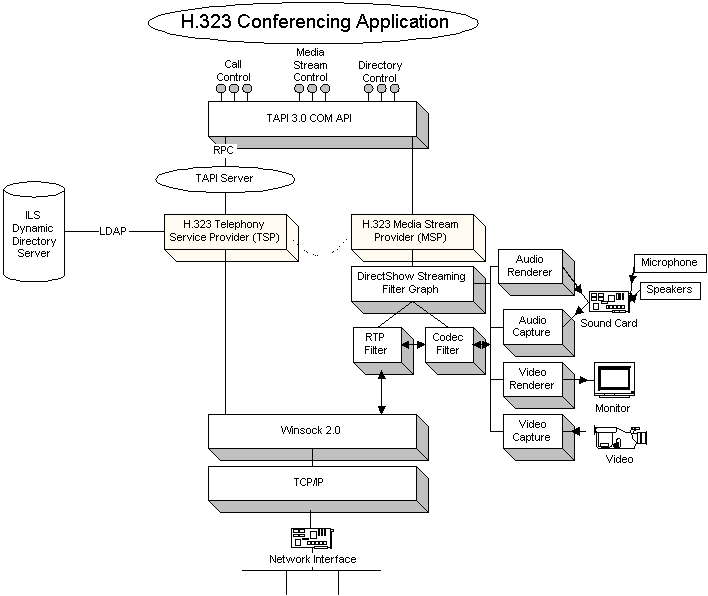
H.323 telephony is complicated by the reality that a user's network address (in this case, a user's IP address) is highly volatile and cannot be counted on to remain unchanged between H.323 sessions. The TAPI H.323 TSP utilizes the services of the Windows NT Active Directory to perform user-to-IP address resolution. Specifically, user-to-IP mapping information is stored and continually refreshed using the Internet Locator Service (ILS) Dynamic Directory, a real-time server component of the Active Directory.
The following user scenario illustrates IP address resolution in the H.323 TSP:
1. John wishes to initiate an H.323 conference with Alice, another user on the LAN. Once Alice's video conferencing application creates an Address object and puts it in listen mode, Alice's IP address is added to the Windows NT Active Directory by the H.323 TSP. This information has a finite time to live (TTL) and is refreshed at regular intervals via the Lightweight Directory Access Protocol (LDAP):
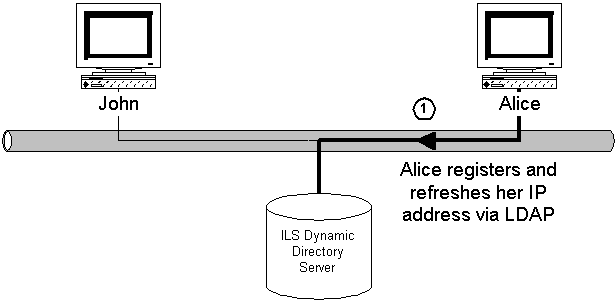
2. John's H.323 TSP then queries the ILS Dynamic Directory server for Alice's IP address. Specifically, John queries for any and all RTPerson objects in the Directory associated with Alice:
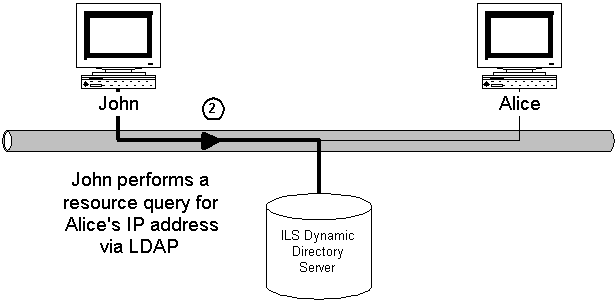
3. Armed with Alice's up-to-date IP address, John initiates an H.323 call to Alice's machine, and H.323-standard negotiations and media selection occurs between the peer TSPs on both machines. Once capability negotiations have been completed, both H.323 Media Stream Providers (MSPs) construct appropriate DirectShow filter graphs, and all media streams are passed off to DirectShow to handle. The conference then begins.
